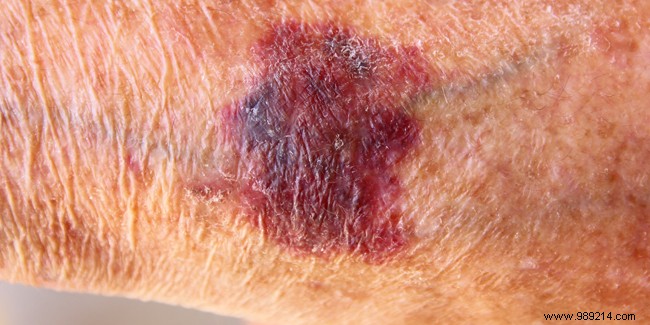
Hematomas, that is to say those marks that most often appear on the skin, due to the bursting of blood vessels, are more frequent in the elderly. They can be due to shocks or falls, which are more common among seniors. But other causes are possible. With age, the blood vessels and the skin naturally become fragile causing the spontaneous appearance of these small pockets of blood. Then, diseases, particularly age-related, increase the risk factors for developing hematomas. Finally, some drug treatments can promote the appearance of these types of hematomas, especially in the elderly.
We talk about hematoma, also called bruise or ecchymosis, to designate an accumulation of blood, that is to say a kind of hemorrhage, in a tissue, even if the hematomas can also appear in a less visible way in the muscles. or certain organs. A hematoma can form in various places on the body such as on the arms, legs, toes, eyelids, under the fingernails, etc.
A hematoma forms under the skin most often, it is then called a subcutaneous hematoma. It then takes the form of a significantly swollen lesion (a sort of lump may be palpable) placed deeper under the skin than a bruise, and dark blue in color due to the presence of a pool of blood. This accumulation of blood is due to the rupture of blood vessels. In the case of a bruise, the symptoms are less pronounced than for a hematoma because, in this case, smaller vessels are affected.
A hematoma in itself does not cause too much pain unless you press on it, but it can on the other hand sore more or less strongly the part of the body where it lodges, especially if the hematoma is important. In the elderly, whose state of health in particular deteriorates over time, hematomas can nevertheless cause more pain and last several weeks when they normally resolve in a short time.
When the accumulated blood, and more precisely the hemoglobin which makes up the red blood cells, deteriorates, the color of the hematoma changes to become progressively green, ocher, then yellow. In general, a hematoma disappears and the skin regains its natural color about ten days after its appearance. However, a hematoma resorbs less quickly than a simple bruise, and often less quickly in older people.
A hematoma most often appears after a major shock (fall or blow), which can be the case in the elderly who are naturally more at risk of falling with age.
Nevertheless, a hematoma can occur spontaneously without the person having bumped into it first because this large bruise can have many other causes.
In the elderly who, over time, have more fragile blood vessels and thinner skin due to the slower renewal of certain cells which in particular prevent the skin from healing quickly and well, the spontaneous appearance of hematomas is a fairly common situation. Note:the weakening of the skin and blood vessels of the elderly can also be due to a deficiency in vitamins C and D, common in seniors.
On the other hand, apart from being older, women are also more prone to bruises and hematomas because their skin is also thinner than that of men.
Finally, prolonged exposure to the sun over a lifetime weakens the skin and blood vessels, as we know. That is why older people in this case are also more prone to the appearance of hematomas, for this reason.
The older you get, the greater the risk of contracting a disease. Some of them can increase the occurrence of hematomas, especially in the elderly.
Thus, hematomas can be caused by diseases, more common in seniors, which cause a drop in platelets, that is to say cells that play a role in blood clotting. This is the case, for example, for people with haemophilia, leukemia, an infectious disease or liver failure.
Spontaneous hematomas can also be due to taking certain anticoagulant drug treatments, that is to say which prevent and delay blood clotting, or avoid the formation of clumps of red blood cells or platelets (antiaggregating treatments) . Treatments often prescribed to reduce the risk of cardiovascular disease, risks that increase with age.
People who take corticosteroids, aspirin, certain antidepressants, asthma treatments, or long-term cortisone are also more prone to hematomas that appear spontaneously.
Cancer treatments, including chemotherapy in particular, can also be the causes of the presence of hematomas that arise spontaneously.